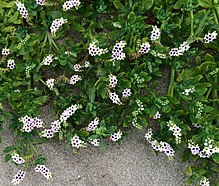Heliotropium curassavicum
| Heliotropium curassavicum | |
|---|---|

| |
| variety oculatum in California | |
| Scientific classification | |
| Kingdom: | Plantae |
| Clade: | Tracheophytes |
| Clade: | Angiosperms |
| Clade: | Eudicots |
| Clade: | Asterids |
| Order: | Boraginales |
| Family: | Boraginaceae |
| Genus: | Heliotropium |
| Species: | H. curassavicum
|
| Binomial name | |
| Heliotropium curassavicum | |
Heliotropium curassavicum, commonly called salt heliotrope[2] (among other names), a species of flowering plant in the borage family (Boraginaceae). It is native to much of the Americas, from Canada to Argentina, including the West Indies and Hawaii. It can be found as an introduced, and sometimes invasive, species in Africa, Asia, Australia, and Europe.[3] It thrives in salty soils, such as beach sand, alkali flats, and salt marshes.[3] It is often found in disturbed coastal sites.[4]
Description
This is a
Names
Due to its wide geographical range that spans many nations and languages, Heliotropium curassavicum has been given an assortment of common names. In English, these include seaside heliotrope, salt heliotrope, monkey tail, quail plant and Chinese parsley. In
Taxonomy
There are five currently recognized varieties.[3] These are:
- H. curassavicum var. argentinum - Native to the tropics of South America, including Argentina, Brazil, Paraguay, and Uruguay.[5]
- H. curassavicum var. curassavicum - Globally widespread, native from the eastern U.S. to Argentina, and naturalized on seashores elsewhere.[3]
- H. curassavicum var. fruticulosum - Endemic to the San Juan and Mendoza provinces of Argentina.[6]
- H. curassavicum var. obovatum - Widespread in western North America and Chihuahua, Mexico.[7]
- H. curassavicum var. oculatum - Native from southwestern Utah to Baja California.[7]
-
Variety curassavicum has the smallest flowers, only 2.5-3.5 mm wide (Bahia Honda Key, Florida)
-
Variety obovatum has flowers 5–10 mm wide, with yellow or slightly purple-tinged throats (Moapa Valley, Nevada)
-
Variety oculatum has flowers 3–5 mm wide with purple throats (Marin County, California)
References
- ^ NatureServe (2023). "Heliotropium curassavicum". Arlington, Virginia. Retrieved 11 November 2023.
- ^ USDA, NRCS (n.d.). "Heliotropium curassavicum". The PLANTS Database (plants.usda.gov). Greensboro, North Carolina: National Plant Data Team. Retrieved 2 February 2018.
- ^ JSTOR 43782784.
- ^ Seaside heliotrope The Institute for Regional Conservation
- ^ Johnston, Ivan (1928). "Studies in the Boraginaceae". Contributions from the Gray Herbarium of Harvard University. 81: 15. Retrieved 2 February 2018.
- ^ Johnston, Ivan (1959). "Some noteworthy American borages". Wrightia. 2 (1): 15. Retrieved 2 February 2018.
- ^ U.S. Dept. of Agriculture. p. 743.
External links
 Media related to Heliotropium curassavicum at Wikimedia Commons
Media related to Heliotropium curassavicum at Wikimedia Commons Data related to Heliotropium curassavicum at Wikispecies
Data related to Heliotropium curassavicum at Wikispecies- Jepson Manual Treatment
- Calflora photo gallery




